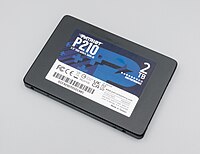
Photo from wikipedia
Due to the unique geometric characteristics and electronic structure of hierarchical 3D nanosheets, they show excellent electron migration rate, ultra‐high specific surface area, and reliable structural stability. Therefore, 3D nanosheets… Click to show full abstract
Due to the unique geometric characteristics and electronic structure of hierarchical 3D nanosheets, they show excellent electron migration rate, ultra‐high specific surface area, and reliable structural stability. Therefore, 3D nanosheets have great application prospects in the field of electrochemical energy storage. Supercapacitor has attracted extensive attention in recent years due to its merits of fast charge and discharge, long cycle life, safety, and stability. Flexibility, miniaturization, and intelligent integration are the development direction of supercapacitor energy storage devices. The emerging 3D printing technology, especially the ink direct writing mode, has greatly improved the design ability and control accuracy of device microstructures. Based on the research progress of 3D graphene nanosheets and 3D MXene nanosheets in the early stage of the authors’ or other teams, this paper proposes to use advanced 3D printing technology to realize the design of flexible all solid‐state supercapacitors by using 3D nanosheets active materials with high specific capacitance. The design methods of interdigital electrodes, multilayer skeleton electrodes and fiber electrodes by 3D printing technology and the performance evaluation of flexible supercapacitor are systematically analyzed. This perspective review aims to provide new conception and theoretical guidance for the design, preparation, and performance optimization of 3D nanosheets‐built materials by 3D printing for the practical application of flexible all‐solid‐state supercapacitor in the future.
Journal Title: Advanced Functional Materials
Year Published: 2022
Link to full text (if available)
Share on Social Media: Sign Up to like & get
recommendations!